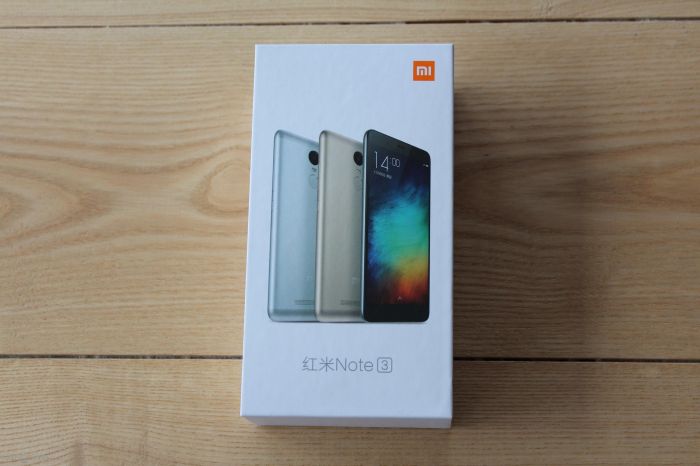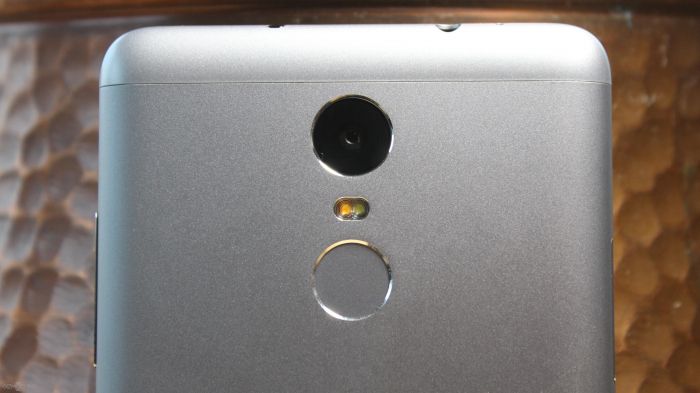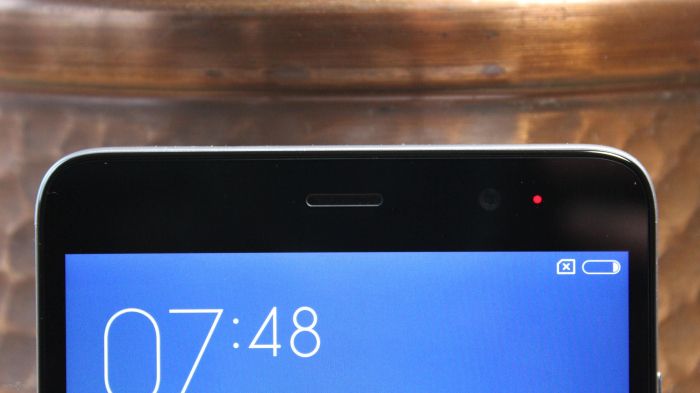The company unveiled the Xiaomi Redmi Note 3 at the end of last month, November 24, and since then, this smart phone has become one of the most popular products in the shops of mobile electronics. This success of this new product was a foregone conclusion, ever since I first started talking about the development of the manufacturer of the metal version of the best-selling this year smartphone Xiaomi Redmi Note 2. Proposed novelty in the press immediately dubbed Redmi Note 2 Pro, as visiting her other innovations except the metal housing and a fingerprint scanner, compared with the original model should hardly be expected. However, the manufacturer has decided to allocate this smartphone into a new generation of devices line Redmi Note, as we learned only a few days before the presentation. And now we can say with confidence that this step was absolutely justified.

Out of the smartphone Xiaomi Redmi Note 3 after only 3.5 months after the launch of the 2nd generation of this line was the kind of response, the company Meizu and LeTV, which previously presented his M1 Metal and Le 1S (X500), respectively. All these devices have in common is in each case from the metal (or metal alloy), and a fingerprint scanner Helio X10 processor. But it Redmi Note 3 beat your opponent by Meizu 33% more RAM, and an opponent of LeTV more capacious battery.

But why smartphone Xiaomi Redmi Note 3 should be considered as a separate device and not an upgrade of the 2nd generation this line? The fact that Redmi Note 3 has received a completely new body design, although it is impossible not to notice the obvious similarity with the smartphone Meizu MX5. Xiaomi company first launched a smartphone with metal rear panel, as well as for the first time in its history, set into the fingerprint reader. And in the course of our review we will try to find out whether the manufacturer has managed to maintain its credibility and not to lose face in the new career for himself as well as to identify other differences from the previous model of this line if it takes place. We will also try to reveal all the secrets of the smartphone Xiaomi Redmi Note 3 and assess its prospects in the market of modern smartphones. We will start, as usual, from the introduction to the packaging of the device, its bundle and a description of the appearance.
Options and appearance.
Smartphone Xiaomi Redmi Note 3 comes in a compact cardboard box in white, on the cover we see a picture of all three color versions of the device. This is a new package design by Xiaomi, and we love it more than the plain cardboard box from a simple brown. Even so, the manufacturer suggests to us that Redmi Note 3 is a separate device and not an updated version of the previous model.
Under the lid of the box you will find a very smart, under which there is an envelope with a manual in Chinese and clip opening Tray SIM-cards and USB-cable and charger 5V / 2A black with fork Chinese standard.
Well, the package proved expectedly poor, and no additional accessories manufacturer did not surprise us.
Package:
-
Smartphone.
-
The charger with a current of 2A.
-
USB-cable black (USB – micro-USB).
-
Guide in Chinese.
-
Clip tray to extract SIM-cards.
Let us turn to the appearance of the smartphone.
Appearance.
We were testing horrible device gray with black faceplate. The very front panel is made of glass, but on its official website the manufacturer does not indicate its brand name. The same pattern was observed with the previous model of this line, and according to unconfirmed reports then it was a glass Dragontrail from Asahi Glass Company. Perhaps in Redmi Note 3 set exactly the same glass.

At the bottom of the front panel there are three touch buttons with the usual smartphone lineup Redmi design. As Redmi Note 2, the novelty buttons are backlit, but this time the manufacturer has made it white, not red. Here we see again a departure from the established traditions, and it is a red light at the time gave its name to the two line of smartphones the company Xiaomi (Redmi and Redmi Note). Personally, we like the white color is much more, because he is like a premium attached to the smartphone.

At the top of the front panel you will find the front camera, earpiece, light sensor and proximity and light events. It is worth noting that the front edge of the glass panel are rounded, so that fans 2.5D technology may be disappointed. Along the perimeter of the glass front of the device there is a border, but it does not protrude above the surface and protects against scratches when you put down the smartphone screen. Although the manufacturer could have done this in the form of edging protruding bead as the smartphone Lenovo K3 Note, for example, which also applied a protective glass is not of the highest quality.

Most of the back of the smartphone Xiaomi Redmi Note 3 is made of metal. Inserts made of plastic on the top and bottom of the enclosure, which is the traditional solution for smartphones with metal casing. These inserts are painted in the same color as the metal panel have the same texture of the surface and adjacent to the bar pretty tight and smooth.
At the top of the back panel of the device, the center, is the eye of the main chamber, under which you will find a slot dual LED flash with different colors of light, and below – a fingerprint scanner. The diameters of the fingerprint scanner and camera module back is almost the same.
At the bottom of the rear panel you will find the manufacturer’s logo and the net external speaker holes beneath. As smartphone Xiaomi Redmi Note 2, under the net external speaker has a special protruding collar, which prevents the complete overlap of sound waves, when you put the device on a flat surface with the display up.

At the top end of the plastic insert is a hole microphone for noise reduction standard 3.5 mm jack for the headset and the infrared port. While in the lower end of the plastic insert, you will find the Micro-USB connector for charging and data transfer, as well as an opening conversational microphone. Both are shifted to the right when looking at the device from the rear panel.

On the left side face of the housing Redmi Note 2 is a metal tray for two SIM-card format Micro-SIM. Memory card slot in it is not provided. And on the right side face of the body of the smartphone are the power button and volume control. They are made of metal, not hang out and have a moderate effect pressing.
The back panel of the housing smartphone Xiaomi Redmi Note 3 is a permanent, almost like all modern devices, where the material is used for its metal. In other words, access to the battery of the smartphone is not here. The network has already met the photos that the device shown in exploded view. According to him, we learned that the frame of the smartphone is made of plastic instead of metal, as expected, but for us this fact maloznachim, because the build quality Redmi Note 3 is at a very high level. In his instance, we did not detect the slightest hint of a backlash or creaks. The front panel is not “playing” in the corners, the rear lid does not flex, and bend the body of the smartphone, for example, in your pocket, is very problematic. So, for the construction of housing Redmi Note 3 manufacturer can put a solid top five.
The thickness of the body of the device is 8.65 mm and the width and height – 76 mm and 150 mm, respectively. The weight of the smartphone Xiaomi Redmi Note 3 was 164 grams. Compared with its predecessor, the new product is 2 mm shorter, nearly 0.5 mm thick and 4 grams heavier, but in the hand Redmi Note 3 feels more delicate due to the rounded edges of the housing. And if we consider that the manufacturer has determined there is almost 30% more capacious battery, then to the dimensions of new items we do not raise any claims. The same can be said about ergonomics Redmi Note 3 as a whole.
Next, we discuss the technical part of the smartphone, beginning, according to tradition, from the display.
Display.
Diagonal screen smartphone Xiaomi Redmi Note 3 is 5.5 inches. Manufacturer set here IPS-matrix with a resolution of Full HD. Although the matrix manufacturer is not known to us, at first glance it is clear that it is of high quality. Display Redmi Note 3 has a high margin of brightness, which is enough for comfortable work in direct sunlight. The manufacturer has equipped the unit with the same features that we saw in the model Redmi Note 2 – improving the readability of the image in the sun, night mode with a low minimum brightness and the reading mode to protect your eyes from the blue glow that causes fatigue.

The viewing angles of the display, thanks to the absence of air gap between the cover glass and the LCD-panel, the traditionally high. The manufacturer claims they at 178 °, and we had no reason not to trust there is the data. Moreover, the image at an angle almost distorted, because changes color shades we have not noticed, and blowing out if there is, it is quite small.
The test Multitouch program AnTuTu display Redmi Note 3 showed support 10 simultaneous touches. Although the display of the previous model showed the same performance matrix in the old and new model are different. This is clearly seen when comparing full-time, especially in the display white and color in general. Which established in both smartphones matrices better – judge for yourself, but we liked the picture on the display Redmi Note 3, although this estimate is very subjective.
Let us turn to the review interface Xiaomi Redmi Note 3.
interface and software platform.
We tested the unit came with an official English-Chinese firmware MIUI V7.0.9.0. And although later we found a newer version of the firmware having the designation V7.0.11.0 and we later replaced by a custom version of its Russified by multirom.me, to acquaint you with the interface Redmi Note 3, we will for the very version of the software that was originally in the smartphone out of the box. We do this for the sole reason that any significant changes in the interface, new versions of the firmware, we have not found.
So, as we said in our review sample is running Android 5.0.2 Lollipop with proprietary shell MIUI7. Shell interface is very responsive and nimble, and slide your finger across the screen quite easily by applying to its protective glass oleophobic coating. Any lags and friezes in the interface, we have not found.

Three touch-sensitive buttons with the already familiar to us the design perform standard functions. Press the button on the left you open the menu of running applications, or so-called “multitasking bar.” In it you will be able to upload an application from the phone memory or free memory device with one touch. Central touch button smartphone Xiaomi Redmi Note 3 serves as a “home.” It is also possible to assign an additional function to be activated at long button held down. A right touch button device performs the action «Back».
With the swipe of the center button to the right you can activate the control mode smartphone with one hand, where the size of the desktop and all the icons on it are reduced, and the image moves in the lower right corner of the screen. Lefties can configure this function so that the image is shifted to the lower left corner of the screen. Swipe down from the status bar (the area at the top of the screen) you open the Quick Launch toolbar various functions such as the activation of silent mode, the activation of wireless connections and data, change the screen brightness, turn on the flashlight and others. From here you can also go to the settings menu of your smartphone. And if from the same panel, swipe right to do, then you’ll be in the notifications panel.
With the swipe two fingers together on the desktop, you open the menu settings. Here you will be able to sort the application shortcuts on the desktop, configure widgets or wallpaper, and configure desktops turning effect.
Consider some menu items smartphone. For example, in “About phone” you will find the function of a wireless update. At the time of our testing with this function, we found that our Redmi Note 3stala available to download firmware version 7.0.12.1, but neither download nor install it “over the air” was impossible.
Also, we do not we can not ignore the presence of the unlocking function smartphone via fingerprint scanner. Customize it work you can in the menu “Password and a fingerprint.” It should be noted that the registration of a take you no more than 10 seconds, and the function allows you to unlock the device from sleep mode, even without prior awakening. The fingerprint scanner works very quickly and accurately, and to put a finger on the sensor can be at any angle. And we can say with confidence that the company Xiaomi coped with this task perfectly well, despite the fact that it was her first experience in this area.
Among the other interesting features in the setup menu of the smartphone is still possible to note the presence of regime for children, the possibility of fine-tuning the display (color temperature and contrast), color selection indicator for a variety of events notification (additional settings) as well as the function of improving the sound in the headphones. In addition to the advanced settings you can activate the wake smartphone using the volume buttons, though familiar to us other smart features, such as dual awakening tapom or smart gestures, settings smartphone Redmi Note 3 is not provided.
Finally, we should mention the presence of the device settings energy saving modes, which will be beneficial for the efficient use of battery power, even though it is quite a decent capacity.
To transfer data between devices in the smartphone Xiaomi Redmi Note 3 you will find a feature Bluetooth, and NFC and HotKnot features you will not find here. However, this point is more than compensated by the built-in infrared transmitter, with which you can remotely control home appliances (TVs, air conditioners, etc.).
Please note that at the time of writing this review in smartphones Xiaomi Redmi Note 3 the ability to install the official Russian firmware updated “over the air” is missing. Moreover, the manufacturer is currently not yet unlocked bootloader (boot) for smartphones this model, which means that the standard methods to flash through the stock rekaveri you can not, as well as get a route-right for your smartphone. In other words, at this point you have several options to resolve the situation:
1) Use the version of the software that will be installed in your machine. If this is the official version of the firmware in English and Chinese, you will be provided with “on air”, but will not be the Russian language.
2) If you get a machine with a Russified version of the firmware from the seller then update “over the air” to you will not receive or will not be installed. In this case you will have to settle for this version of the software, either independently establish other by computer. Installation options can be found here or on any other similar resources.
3) wait for the smartphone Xiaomi Redmi Note 3 at authorized dealers in your country, or to cancel the purchase of this device in favor of devices from other manufacturers, which set international firmware already from the factory.
One of the options for installing firmware Russified Xiaomi Redmi Note 3 you can find in this video. As will be further development of the situation with the software in the smartphone Xiaomi Redmi Note 3, we will inform you on our website and in our group network vkontakte.
Now, move on to testing smartphone Xiaomi Redmi Note 3 in the various benchmarks, began, as usual, with a test program AnTuTu.
Performance testing and other benchmarks.
Smartphone Xiaomi Redmi Note 3, as we have said before,
No comments:
Post a Comment